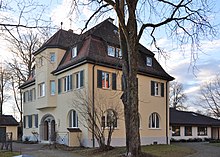Evangelical town church in Wangen im Allgäu
The city church was the first and is the largest Protestant church in the city of Wangen im Allgäu . It was built in neo-Gothic style from 1890 and inaugurated in 1893 in the presence of King Wilhelm II .
location
The church is located on Bahnhofsplatz between the train station and Gegenbaurstraße , behind which the old town begins. A footpath leads down the hill to Gegenbaurstraße.
history
prehistory
Until 1802, Wangen was a purely Catholic imperial city . After the affiliation to the Duchy of Bavaria (Kingdom from 1806) in that year, an influx of Protestants would have been legally possible. In fact, after the annexation to the Kingdom of Württemberg in 1810, there were individual immigrants, mainly from civil servant families from Old Württemberg . Evangelical church services, led by Isny pastors, took place from 1824 in the Catholic Martinskirche and the church of the Capuchin monastery that no longer exists today . In 1834 there were 77 evangelicals, in 1846 204, in 1883 500. From 1835, King Wilhelm I allowed eight services each year, then one each month. In 1850 a permanent parish administration with regular Sunday services was set up, and there was now a separate pastor. In 1851, with the support of the Gustav-Adolf-Verein , a part of the former Capuchin monastery was bought as a room , in which a prayer room consecrated in 1853 by general superintendent Albert von Hauber was set up. There was also a school in the former monastery from 1880. These buildings became too small due to the increasing number of parishioners, so that the parish administrator of Alsace applied for a church building, which was approved by the Royal Evangelical Consistory in 1887 .
Building history
Theophil Frey was the architect of the neo-Gothic building . The church building was initially unplastered from 1890 and inaugurated on October 19, 1893. King Wilhelm II and his wife Charlotte were present. Originally the church was to be built on Lindauer Straße, but it was built in an area between the train station and the city center that was largely undeveloped at the time.
On the other side of the way between the train station and the city, the rectory was built in 1907/08, to which the parish hall has been an extension since 1979/80. In 1913 the church was renovated for the first time and a small porch was added. Since 1920 the choir arch has been completely decorated with a painting by Rudolf Schäfer (which he reworked in 1951) ; Paintings that were also created on the side surfaces were later painted over. At a similar time, between 1920 and 1922, the church received bells again after the three bells were drawn in to be melted down during the First World War . One of the bells came back, the other two were replaced.
Due to the expellees after the Second World War , four times as many Protestants now lived in the area of the Wangen parish, namely 1600, and roughly the same number still lived in the parishes that Wangen looked after. Therefore, the churches in the Wittwais and Amtzell were built in 1960–1963 .
In 1971 the interior of the church was repaired and a new organ was built. In 1993 the exterior of the church was refurbished, 2010–2011 the interior was renovated.
Building description and equipment
The Protestant town church is a cross-shaped hall church , with the choir facing northeast. The tower, which does not have a clock, is located above the entrance room, which can be reached from the outside via a staircase in the porch open to the outside. A side entrance can be reached via a ramp and is therefore barrier-free.
The organ is on the gallery. The choir arch is provided with a painting by Rudolf Schäfer, which shows, among other things, the Lamb of God . The wooden pulpit is seen from the entrance to the right of the choir on the archway.
organ
In 1971 a new organ with 13 sounding stops and mechanical action by Weigle was built into the historic organ case . In the course of the interior renovation 2010-2011, the organ was re- voiced and expanded. She has the following disposition :
|
|
|
||||||||||||||||||||||||||||||||||||||||||||||||||||||||||||||||||||||||||||||||||||||||
- Coupling : II / I, I / P, II / P
Parish priest
- 1889–1903 (administrator since 1888): Karl Fauser
- 1904–1928: Konrad Mack
- 1929–1939: Geiser
- 1939–1940: Hauser
- 1940: Shepherd
- 1941: butcher
- 1941–1947: Wurster
- 1949-1951: Duncker
- 1952–1968: Alfred Finckh
- 1968–1984: Rudolf Bögel
- 1985–1994: Gerhard Schaz
- 1994–1998: Alfred Gronbach
- 1998–2011: Jakob Betz
- since 2012: Martin Sauer
literature
- Rainer Jensch: City Chronicle Wangen im Allgäu . Kunstverlag Josef Fink, Lindenberg im Allgäu 2015, p. 478ff.
Web links
- Website of the Protestant parish of Wangen
Individual evidence
- ↑ a b c d e f g Information on the Church , Evangelical Church Community Wangen, accessed on September 26, 2016
- ↑ Information on the organ , Evangelical Church Community Wangen, accessed on September 26, 2016
Coordinates: 47 ° 41 ′ 18.8 " N , 9 ° 49 ′ 57.2" E




